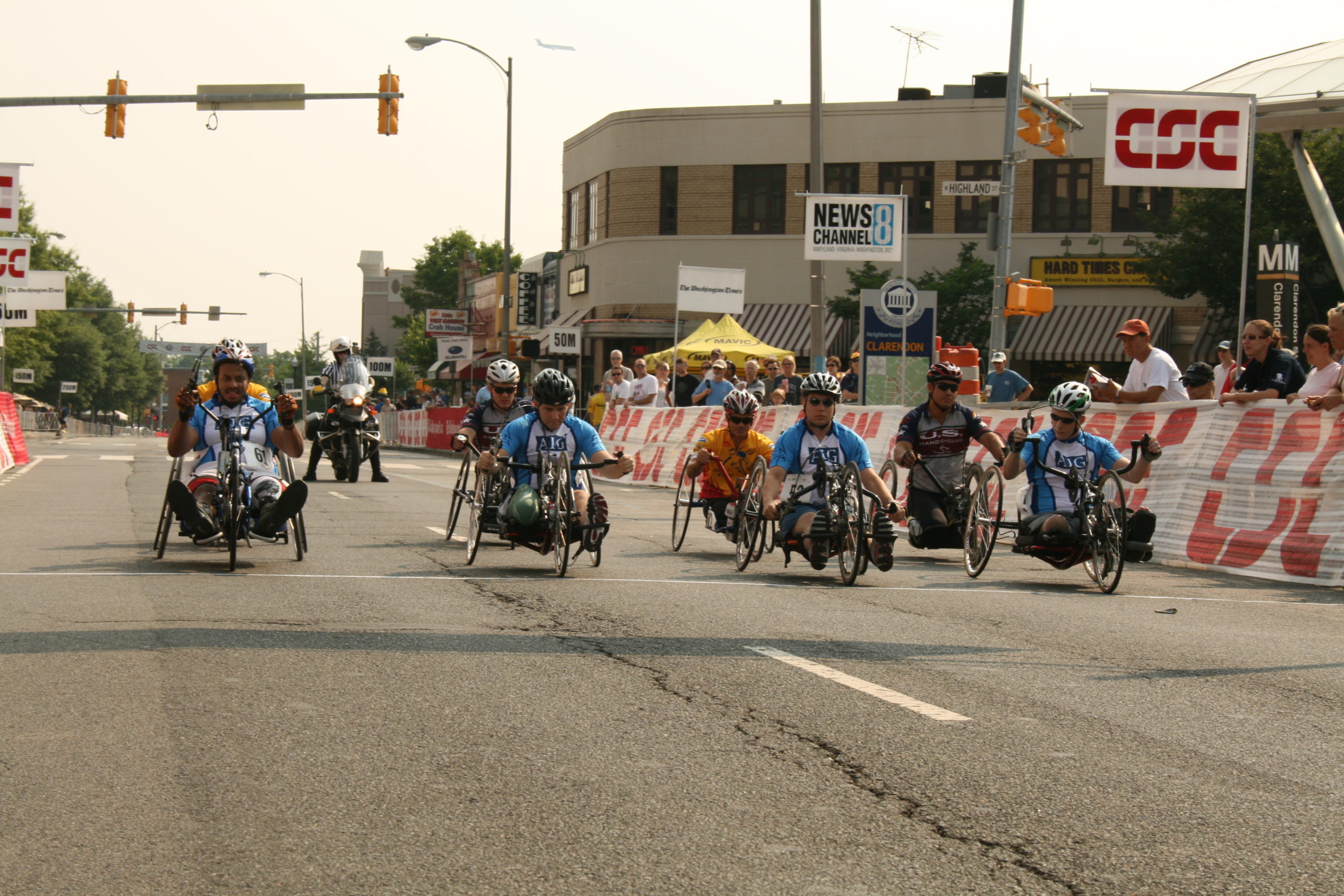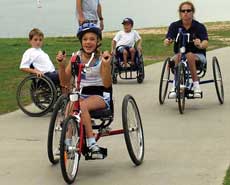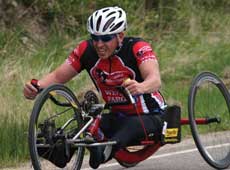
Hand Cycling
Becoming Familiar with Handcycling
Handcycling was developed in the 1980s by people working to create alternate types of human-powered vehicles. So it was almost by accident that a new world of cycling was opened to people with disabilities.
 “It’s ideal for people who have no or limited use of their legs, people who have poor balance, or anyone that just wants to try a different sport,” said Heather Plucinski of Challenge Alaska. “It opens up a lot of trails and a lot of countryside, a lot of fresh air, and a lot of places you can travel.
“It’s ideal for people who have no or limited use of their legs, people who have poor balance, or anyone that just wants to try a different sport,” said Heather Plucinski of Challenge Alaska. “It opens up a lot of trails and a lot of countryside, a lot of fresh air, and a lot of places you can travel.
It’s a great piece of adaptive equipment that allows people to get outside.”
“The disabled community picked up on it right away,” said Ian Lawless, Colorado regional director and cycling director for Adaptive Adventures. Even people with one working arm can handcycle with some modifications made to the equipment, said Lawless. “Just about anyone can do it. It’s an accessible sport. It’s not just for racing; it’s also for recreational riding. It’s a barrier breaker that allows a disabled rider to participate in cycling with friends and families who may be riding conventional bicycles.”
In the 25 years since its development, handcycling has continued to grow in popularity. It’s been part of the IPC cycling program since 1998, and the 2004 Paralympics included handcycling racing for the first time. Today, thousands of people, able-bodied and those with disabilities, have turned to handcycling as a means to improve their cardiovascular health, increase upper-body strength, compete, and ride with friends and family.
In 1999, Challenge Alaska added a handcycling division to its race, the Sadler Ultra Challenge. Since then, Plucinski said, the handcycling division has doubled and tripled in size while the wheelchair division has shrunk. The Sadler Ultra Challenge is a grueling six-day, 267-mile race described as “the holy grail” of wheelchair and handcycle racing. It attracts competitors from around the world.
But a handcycle is not a racing wheelchair, Lawless is quick to note. “Handcycling is cycling. Wheelchair racing is adaptive running. They cannot be included in the same division because handcycles have inherent advantages in speed and gearing.” While racing wheelchairs are really made just for racing, handcycles can be used for a variety of activities, Lawless said. “The racing part of it is a small part in reality. You can purchase one just to get around the neighborhood, to go on cross-country trips, or to race.” There are even off-road handcycles for those who want to head off into rough terrain.
Programs Near You
Ready to try out a handcycle. Check out these 60+ Move United Member Organization to find a program near you!
Can’t find a chapter near you? There are numerous handcycling programs throughout the country.
Equipment
Types of Handcycles
Handcycles benefit from today’s lightweight racing technology, using lightweight materials and thin-wall tubing for decreased weight and increased strength. Current racing cycles weigh about 25 lbs. to 30 lbs. and are getting lighter all the time, Lawless said. There are a few basic styles of handcycles, along with a variety of options to suit most riders’ interests, from recreational to competitive riding.
An upright handcycle is an entry-level bike for those who are new to the sport, who just want exercise or recreation, or who don’t want to ride very long distances or go very fast. Because of their higher center of gravity, upright handcycles aren’t suitable for speeds higher than 15 mph. The internal gear.
A recumbent handcycle, borrowed from the cycling industry, usually come in a choice of three or seven speeds, which naturally limits the speed to less than 15 mph. They are easy to transfer in and out of from a wheelchair, and have a natural, fork-type steering system.
Recumbent handcycles come in a few different variations. There are two steering options: fork-steer and lean-to-steer, and two seating options: one where the rider reclines and the other, a “trunk-power” version, where the rider leans forward. They usually come with 27-gear drivetrains, although they can be purchased with three- or seven-gear drivetrains.
 The trunk-power handcycle doesn’t have much of a seatback. The cranks are low to the ground and far away from the rider. With this arrangement, riders are able to put the weight of their trunks behind each stroke, allowing them to go faster for longer. The limitation to this type of handcycle, Lawless said, is that the athlete must have control of most or all of his abdominal muscles, so it may not be.
The trunk-power handcycle doesn’t have much of a seatback. The cranks are low to the ground and far away from the rider. With this arrangement, riders are able to put the weight of their trunks behind each stroke, allowing them to go faster for longer. The limitation to this type of handcycle, Lawless said, is that the athlete must have control of most or all of his abdominal muscles, so it may not be.
With the other seating option, the rider sits in a seat with a reclined back. The cranks are higher and closer, allowing the rider to use the seatback for leverage to rotate the cranks.
Of the two types of steering options, the fork-steer version is probably the more popular. It uses a traditional frame where the fork turns independently. These types work well for people with both low-level and high-level disabilities. Most have adjustable footrests and seat angles, and come in a variety of configurations depending on the intended use.
The lean-to-steer version has a two-piece frame where the top frame swivels over the bottom frame. The front wheel turns along with the seat. The rider initiates the turn by leaning his whole body. There is a bit of a learning curve with this type, but many riders prefer this type because they have a feel similar to monoskiing. They’re used primarily, but not exclusively, by people with lower-level disabilities. Lawless said there’s no advantage of one type of steering over the other. It’s primarily a matter of the athlete’s preference.
There are also handcycles for the young and those with shorter legs. Invacare manufactures one with a low center of gravity, with adjustable footrests to accommodate a growing child.
New handcycles can range in price from $1,500 to $7,000, although you may be able to find a deal on a used model. Some of the major manufacturers include Invacare, Sunrise Medical, Freedom Ryder, and Lightning. But, Lawless said, “I would absolutely recommend against buying a handcycle that you haven’t tried or sat in.”
Lawless said someone who’s interested in buying a handcycle should attend one of the dozens of clinics that are held across the country each year, usually put on by a Move United Member Organization. If a clinic isn’t available, many dealers and non-profit groups have equipment you can try before you buy. There are also numerous online resources available that may be able to put you in touch with someone in your area who may own the equipment themselves.
Handcycle Suppliers
To Learn More
USA Hand Bike Race Circuit- USA Hand Bike Circuit
National Governing Body- USA Cycling
Paralympic Cycling- Team USA

